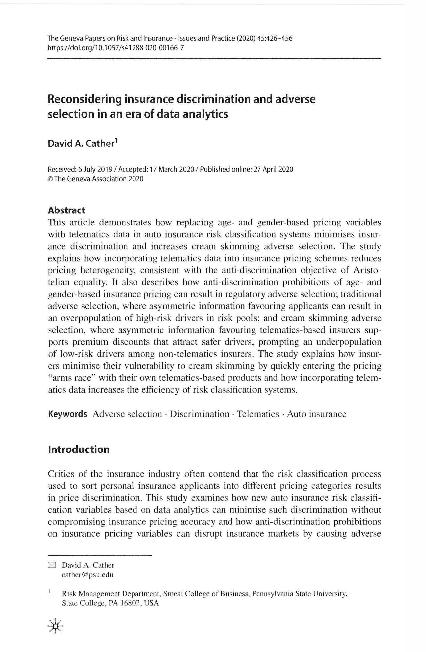pricing heterogeneity, consistent with the anti-discrimination objective of Aristotelian equality. It also describes how anti -discrimination prohibitions of age- and gender-based insurance pricing can result in regulatory adverse selection; traditional adverse selection, where asymmetric information favouring applicants can result in an overpopulation of high-risk drivers in risk pools; and cream skimming adverse selection, where asymmetric information favouring telematics-based insurers supports premium discounts that attract safer drivers, prompting an underpopulation of low-risk drivers among non-telematics insurers. The study explains how insurers minimise their vulnerability to cream skimming by quickly entering the pricing "arms race" with their own telematics-based products and how incorporating telematics data increases the efficiency of risk classification systems.Related records: En: Geneva papers on risk and insurance : issues and practice. - Geneva : The Geneva Association, 1976- = ISSN 1018-5895. - 01/07/2020 Volumen 45 Número 3 - julio 2020 , p. 426-456Materia / lugar / evento: Análisis de datos Selección adversa Seguro de automóviles Clasificación de riesgos Telemática Matemática del seguro Other categories: 6
Reconsidering insurance discrimination and adverse selection in an era of data analytics

Contenido multimedia no disponible por derechos de autor o por acceso restringido. Contacte con la institución para más información.
pricing heterogeneity, consistent with the anti-discrimination objective of Aristotelian equality. It also describes how anti -discrimination prohibitions of age- and gender-based insurance pricing can result in regulatory adverse selection; traditional adverse selection, where asymmetric information favouring applicants can result in an overpopulation of high-risk drivers in risk pools; and cream skimming adverse selection, where asymmetric information favouring telematics-based insurers supports premium discounts that attract safer drivers, prompting an underpopulation of low-risk drivers among non-telematics insurers. The study explains how insurers minimise their vulnerability to cream skimming by quickly entering the pricing "arms race" with their own telematics-based products and how incorporating telematics data increases the efficiency of risk classification systems.Related records: En: Geneva papers on risk and insurance : issues and practice. - Geneva : The Geneva Association, 1976- = ISSN 1018-5895. - 01/07/2020 Volumen 45 Número 3 - julio 2020 , p. 426-456Materia / lugar / evento: Análisis de datos Selección adversa Seguro de automóviles Clasificación de riesgos Telemática Matemática del seguro Other categories: 6

